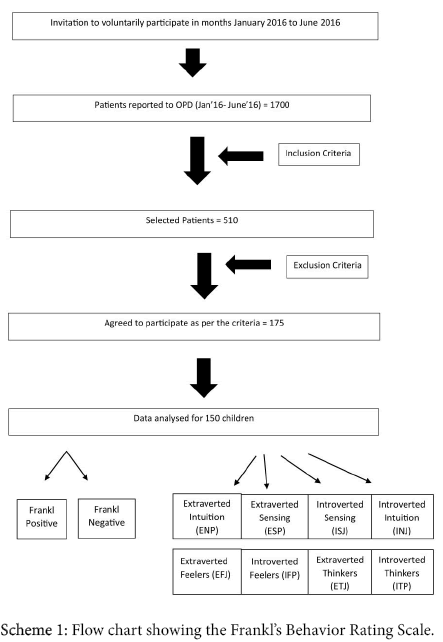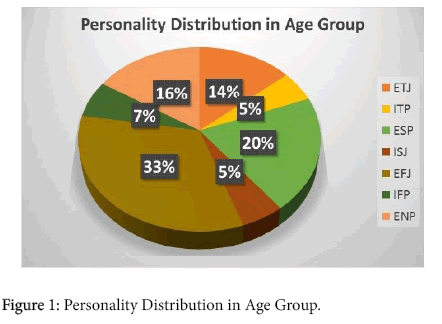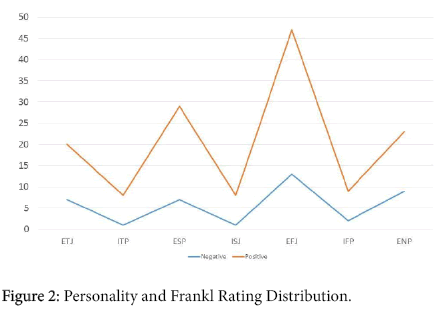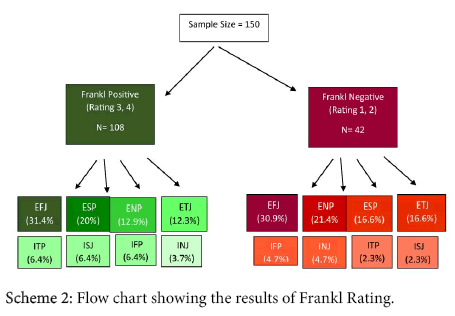Behavior Assessment using Frankl Rating Scale and Identification of Personality in Pediatric Dental Operatory
Received: 21-Jul-2017 / Accepted Date: 26-Aug-2017 / Published Date: 10-Sep-2017 DOI: 10.4172/2375-4494.1000356
Abstract
Aim: To establish a correlation between the personality type (using Myers Briggs Type Indicator (MBTI)) and cooperation in dental operatory (using Frankl Behaviour Rating) of 7-12 year old children. Materials and
Method: A qualitative double blind study was planned that collected data from 150 children in the age range of 7-12 years accompanied by parents. The parents were provided with MBTI questionnaire for children while they were in the waiting area and the behaviour of the child is assessed by experienced staff and rated according to Frankl’s Behaviour Rating Scale. The data obtained were subjected to statistical analysis.
Results and Discussion: Positive Frankl Rating was associated with ITP (Introverted Thinkers)=ISJ (Introverted Sensing) (88%)>IFP (Introverted Feelers) (78%)>EFJ (Extroverted Feelers) (74%). Negative Frankl Rating was associated with ENP (Extroverted Intuition) (39%)>ETJ (Extroverted Thinkers) (35%)>INJ 9Introverted Intuition) (33%)>EFJ (Extroverted Feelers) (28%). Introverts with thinking or perceiving personality type children presented higher levels of cooperation as compared to Extroverts, with intuitive or judging personality traits, however, no significant correlation could be established between the two (p=0.406).
Conclusion: Behaviour management techniques could be modified according to personality type of a child. However, further studies need to be undertaken to establish a correlation between the personality type and cooperation of the child in dental operatory.
Keywords: Personality; Behaviour; Parent; Children; Assessment
13280Introduction
The concept of behaviour management has evolved from the notion of dealing with the child to building a relationship between the child, the parent and the dentist that is focused on meeting the child’s oral health needs [1]. Behavioural and personality models have been used by philosophers, leaders and managers for hundreds and in some cases thousands of years as an aid to understanding, explaining, and managing communications and relationships [2].
One of the more reliable and frequently used behaviour rating systems in both clinical dentistry and research is the Frankl Scale. This scale (see Appendix 1) separates observed behaviours into four categories ranging from definitely negative to definitely positive [3].
The Myers-Briggs Type Indicator (MBTI) was developed by Isabel Briggs Myers and her mother, Katherine Briggs in 1940s based on the work of Carl Jung and reports a person’s preferred ways of attending to the world and making decisions based on psychological types [4]. The purpose of the MBTI is to “identify, from self-report of easily recognized reactions, the basic preferences of people in regard to perception and judgement, so that the effects of each preference, singly and in combination, can be established by research and put to practical use” [5].
Generally, the MBTI is most appropriately administered to high school-aged persons and adults. However, it has been used successfully with middle grade students. The children's aged 7-12 personality categories recognized coincide with the original personality types identified by Carl Jung, before the types were expanded upon by Katharine Briggs and Isabel Myers. No study has been undertaken so far co-relating the behaviour of the child to their personality traits, pertaining to application of appropriate behaviour management technique in dental operatory for this age group.
The purpose of the study is to establish a correlation between the personality type (using MBTI) and cooperation (using Frankl Behaviour Rating) in pediatric dental operatory.
Materials and Methodology
This is an observational study that has collected data from 150 children reporting to the Department of Pedodontics and Preventive Dentistry with no previous dental exposure.
Inclusion Criteria
• Children accompanied by parents
• Aged 7-12 years
• School going children
• Children with no previous dental exposure.
Exclusion Criteria
• Children accompanied by guardians other than parents
• Medically compromised children or children with disabilities.
The parents accompanying the children aged 7-12 years were approached and requested to participate and the procedures and purpose of study was explained in detail to them. Once they agreed, written informed consents were taken. The parents were provided with MBTI questionnaire for children while they were in the waiting area. The children stayed in the play room while the questionnaire was being filled by the parents. The said questionnaire proforma was in English. Parents who could read and write in English and were willing, filled the details themselves. However the interviewer was present at all times with the parents while they were filling the form to clear any doubts, in the local language if required. Custom made questionnaire form was also converted in Hindi by local persons who knew both languages.
For parents unable to read, write or comprehend the questionnaire, the interviewer asked each question on a one to one interview basis in the local language while maintaining a uniform method of questioning for all parents interviewed. The answers given were marked on the form simultaneously along with noting down of any additional information provided by the parents. Participation was voluntary and data was handled confidentially.
The behavior of the child was assessed by experienced staff and rated according to Frankl’s Behavior Rating Scale. The assessment was done first during examination and later during different dental procedures. The assessment was done for up to 3 visits.
All the data obtained was punched using Microsoft excel and subjected to statistical analysis. Based on the results obtained, necessary conclusions were drawn and recommendations made (Scheme 1).
Results
A total of 150 children in the age group of 7-12 years were included in the study. Of these, 84 (56%) were boys and 66 (44%) were girls.
45 (30%) were 7 year olds, 25 (16.67%) 8 year olds, 33 (22%) 9 year olds, 28 (18.67%) 10 year olds, 5 (3.32%) 11 year olds and 14 (9.34%) 12 year olds (Figures 1 and 2).
In the concerned age group of 7-12 year olds, 32% were EFJs, 20% were ESPs, 15% were ENPs, 13% were ETJs, 7% were IFPs, ITPs and ISJs were 5% each and INJs were 4%.
16 (35.5%) out of 45; 7 year olds showed negative behavior along with 11 (44%) out of 25 year olds, 10 (29%) out of 34, 9 year olds, 3 (10%) out of 28, 10 year olds, 1 (20%) out of 5, 11 year olds and 1 (7%) out of 14, 12 year olds. Positive behavior was exhibited by 55.5% of 7 year olds, 56% of 8 year olds, 71% of 9 year olds, 90% of 10 year olds, 80% of 11 year olds and 93% of 12 year olds (Table 1 and Scheme 2).
| Type | General Prevalence | Present Study |
|---|---|---|
| ENP (Extroverted Intuition) | 11.30% | 15% |
| ESP (Extroverted Sensing) | 12.80% | 20% |
| ETJ (Extroverted Thinkers) | 10.50% | 13% |
| EFJ (Extroverted Feelers) | 14.80% | 32% |
| INJ (Introverted Intuition) | 3.60% | 4% |
| ISJ (Introverted Sensing) | 25.40% | 5% |
| ITP (Introverted Thinkers) | 8.70% | 5% |
| IFP (Introverted Feelers) | 13.20% | 7% |
Table 1: Table showing the personality types according to Frankl rating.
Among the personality types, Positive Frankl Rating was associated with ITP=ISJ (88%)>IFP (78%)>EFJ (74%). Negative Frankl Rating was associated with ENP (39%)>ETJ (35%)>INJ (33%)>EFJ (28%) (Tables 2 and 3).
| Age (in years) | Negative (Rating 1 and 2) | Positive (Rating 3 and 4) | ||||
|---|---|---|---|---|---|---|
| Frankl Rating | Rating 1 | Rating 2 | Total | Rating 3 | Rating 4 | Total |
| 7 (45) | 1 | 15 | 16 (35.5%) | 25 | 4 | 29 (55.5%) |
| 8 (25) | 1 | 10 | 11 (44%) | 13 | 1 | 14 (56%) |
| 9 (34) | 10 | 10 (29%) | 20 | 4 | 24 (71%) | |
| 10 (28) | 3 | 3 (10%) | 24 | 1 | 25 (90%) | |
| 11 (5) | 1 | 1 (20%) | 4 | 4 (80%) | ||
| 12 (14) | 1 | 1 (7%) | 9 | 4 | 13 (93%) | |
Table 2: Age and Frankl rating distribution (p-value: 0.115).
| Personality Type | Negative (Rating 1 & 2) | Positive (Rating 3 & 4) | ||||
|---|---|---|---|---|---|---|
| Rating 1 | Rating 2 | Total | Rating 3 | Rating 4 | Total | |
| ETJ (20) | 2 | 5 | 7 (35%) | 12 | 1 | 13 (65%) |
| ITP (8) | 1 | 1 (22.5%) | 7 | 7 (87.5%) | ||
| ESP (29) | 7 | 7 (25%) | 20 | 2 | 22 (75%) | |
| ISJ (8) | 1 | 1 (22.5%) | 7 | 7 (87.5%) | ||
| EFJ (47) | 13 | 13 (27.6%) | 26 | 8 | 34 (72.3%) | |
| IFP (9) | 1 | 1 | 2 (22%) | 6 | 1 | 7 (78%) |
| ENP (23) | 1 | 8 | 9 (39%) | 13 | 1 | 14 (61%) |
| INJ (6) | 2 | 2 (33%) | 4 | 4 (67%) | ||
Table 3: Personality and Frankl rating distribution (p-value: 0.406).
However, no significant correlation (p=0.406) could be established between the MBTI personality and Frankl Behavior Rating in 7-12 year olds.
Discussion
One of the most extensively used rating scales to assess dental anxiety in children in the dental setting was developed by Frankl [6]. This scale, completed by the dentist, categorizes the child's behavior in different situations as either definitely positive (4), positive (3), negative (2), or definitely negative (1) (Appendix 1). The instrument has shown satisfactory reliability and moderate at best validity. However, a major drawback of Frankl's RS is the lack of uniformity in the use of the scale in the reviewed studies: it appears that there are as many modified Frankl Rating Scales as there are studies using this scale, making results incomparable [4].
Myers-Briggs Type Indicator or MBTI [5] is an extremely popular personality inventory which has received widespread use over the last 30 years [7]. The MBTI is a self-report questionnaire designed to quantify non-psychopathological personality types as postulated in Jung's psychodynamic type theory [5]. The questionnaire is internet based. The standardized survey instrument used for personality type assessment is the MBTI Form G which includes 44 forced-choice questions. The choices are a mixture of word pairs and short statements. They are not literal opposites but chosen to reflect opposite preferences on the same scale. The questionnaire consists of 5 sections assessing the personality type on the basis of: 1. Social interactions (family, friends and strangers), 2. Coping skills, 3. Approach to problem solving, 4. Initiative/ curiosity to learn and 5. General attitude. Each of the items is scored on one of four scales. The scales are composed of pairs of opposite preferences, with a range between them and a midpoint. The preferences include Extraversion/Introversion (EI) - the direction we focus our attention & energy, Sensing/Intuition (SN) - the way we take in information, Thinking/Feeling (TF) - the way we make decisions, and Judgement/Perception (JP) - the way we act in the outer world.1 The Myers-Briggs Type Indicator® (MBTI®) assessment has helped millions of people worldwide gain insights about themselves and how they interact with others—and improve how they communicate, learn, and work. It provides a powerful framework for building better relationships, driving positive change, harnessing innovation, and achieving excellence. Students’ academic achievement levels and student satisfaction in nursing were found to vary according to their MBTI personality types [8].
The behavior of a child in the dental operatory could be attributed to his personality traits and questions from how the child would choose to communicate to how he might react in a certain situation can be answered by identifying his personality type. For instance, Sensing and Intuition, preferences that describe how the information is taken in and the type of information that is trusted by the child. Hence, correlating Frankl Rating Scale and MBTI Personality Indicator can provide reliable information on understanding the child better.
School children aged 7-12 years reporting between Jan 16 to June 16 for dental treatment without any previous exposure were invited for voluntary participation. Out of the total of 1700 who reported, 510 were selected for the study. Children accompanied by caregiver or grandparents and medically compromised or children with disabilities were excluded and finally 175 patients agreed to participate. Data was analyzed for 150 children and classified in two ways. First, into two categories according to Frankl Rating Scale- Frankl Positive and Frankl Negative. Second, into 8 categories in accordance with MBTIExtraverted Intuition (ENP), Extraverted Sensing (ESP), Introverted Sensing (ISJ), Introverted Intuition (INJ), Extraverted Feelers (EFJ), Introverted Feelers (IFP), Extraverted Thinkers (ETJ) and Introverted Thinkers (ITP).
Of the 150 children, 84 (56%) were boys and 66 (44%) were girls. This indicates a male gender dominant society, though the difference was not significant.
In our study, EFJ (Extroversion, Feeling, and Judging) was the most prevalent personality type in all age groups, followed by ESP (Extroversion, Sensing and Perceiving), ENP (Extroversion, Intuitive and Perceiving) and ETJ (Extroversion, Thinking and Judging) with little variations among different age groups. This could be attributed to the fact that with entry into school, the emphasis is on continues socialization. The child tried to build relationships, reaches out and exhibits extroverted behavior. Paralleling this, in this period of concrete operations along with the earlier development of trust, autonomy and initiative makes the child capable of sensing and understanding information and make decisions as per his perception. Positive behavior was observed maximally among all age groups. However, younger age groups exhibited definitely negative behavior while definitely positive behavior was observed in older age groups. This is because during school years, the child evaluates himself according to how well he believes he does in society’s tasks and in how well important people think he does. Hence the child tries to behave in an acceptable manner so as to feel good about himself and achieve Industry over Inferiority. Among the personality types, EFJs exhibited most children with definitely positive behavior, followed by IFPs, ESPs and ETJs. Positive behavior however dominated all age groups. IFPs and ENPs exhibited definitely negative behavior in some cases. However, no significant correlation (p=0.406) could be established between the MBTI personality and Frankl Behavior Rating in 7-12 year olds. The behavior can be explained by the traits of each personality. EFJs are highly sociable little children who strive for harmony in all their relationships. IFPs are easy going, compassionate optimists who try to look at positive in everything. However, they are highly sensitive, very dramatic and hence prone to definitely negative behavior. ESPs are delightful, enthusiastic, and adaptable, usually daring and brave. ETJs are logical and outspoken. They hate to cry and exhibit positive behavior if properly reasoned with [9,10].
It has to be kept in mind that the child’s behavior on dental visit can be influenced by variables like age, parental behavior, parental anxiety, behavior management and procedural techniques followed by the dentist. Also, it is possible to modify the child's personality by application of appropriate behavior management technique and making the dental experience pleasant for him.
Conclusion
• Extraverted Feelers (EFJ), Extraverted Sensing (ESP) and Extraverted Intuition (ENP) were the most common personality types in 7-12 year old children.
• Higher incidence of Frankl rating 3 (+) was seen, however, younger age groups (7-8 year olds) showed incidence of Rating 1 (--) while Rating 4 (++) was seen in 12 year olds.
• No significant correlation (p= 0.406) could be established between the MBTI personality and Frankl Behavior Rating in 7-12 year olds.
• Limitations
• If it would have been a cluster random sampling, which should have been the ideal study design, trained blinded examiners would have been needed by the chief investigator. Bigger, above type of sample planning gives unbiased results which are applicable to whole population of the study area. Our study helps in planning further study at a larger scale.
• 15.3% children do not report to dental clinics and different type of dental diseases and past medical experiences will also affect the perception in dental clinic (CDC/National Center for Health Statistics, May 3 2017). Even parents perception has a huge effect. These children were non-sampled since all cannot be represented. Children accompanied by care giver or grandparents were also non-sampled.
• Only children reporting for treatment to the institute were included (Special Group- Children needing treatment). Hence, they were over represented as all cannot be included in the study.
• Most of the people in the population are from U.P. state with literacy rate of 67.68 % and spoken language though related to Hindi changes every 100 meters. Hence, the translation did not work as per expectation. Help of a local persons who knew both languages were taken for the study.
References
- Casamassimo PS, Fields Jr HW, McTigue DJ, Nowak A (2013) Pediatric dentistry: infancy through adolescence. Elsevier Health Sci.
- Boyle GJ (1995) Myers-Briggs Type Indicator (MBTI): Some psychometric limitations. Aust Psychol 30: 71-74.
- American Academy on Pediatric Dentistry Council on Clinical Affairs (2015) American Academy on Pediatric Dentistry Clinical Affairs Committee-Behavior Management Subcommittee. Guideline on behavior guidance for the pediatric dental patient. Pediatr Dent p. 38.
- Jung CG (1923) On the relation of analytical psychology to poetic art. Psychol and Psychother 3: 213-231.
- Myers IB, McCaulley MH, Most R (1985) Manual, a guide to the development and use of the Myers-Briggs type indicator. Consulting Psychologists Press.
- Frankl SN (1962) Should the parent remain with the child in the dental operatory? J Dent Child 29: 150-163.
- Carlyn M (1977) An assessment of the Myers-Briggs type indicator. J Pers Assess 41: 461-173.
- Kim MR, Han SJ (2014) Relationships between the Myers-Briggs Type Indicator personality profiling, academic performance and student satisfaction in nursing students. J Biosci Biotechnol 6: 1-2.
- Aartman IH, van Everdingen T, Hoogstraten J, Schuurs AH (1996) Appraisal of behavioral measurement techniques for assessing dental anxiety and fear in children: A review. J Psychopathol Behav Assess 18: 153-171.
- Capraro RM, Capraro MM (2002) Myers-Briggs type indicator score reliability across: Studies a meta-analytic reliability generalization study. Educ Psychol Meas 62: 590-602.
Citation: Lakhani B, Indushekar KR, Shalini G, Nayanika S, Ekta T (2017) Behavior Assessment using Frankl Rating Scale and Identification of Personality in Pediatric Dental Operatory. J Child Adolesc Behav 5: 356. DOI: 10.4172/2375-4494.1000356
Copyright: © 2017 Lakhani B, et al. This is an open-access article distributed under the terms of the Creative Commons Attribution License, which permits unrestricted use, distribution, and reproduction in any medium, provided the original author and source are credited.
Select your language of interest to view the total content in your interested language
Share This Article
Open Access Journals
Article Tools
Article Usage
- Total views: 12885
- [From(publication date): 0-2017 - Aug 20, 2025]
- Breakdown by view type
- HTML page views: 11807
- PDF downloads: 1078




